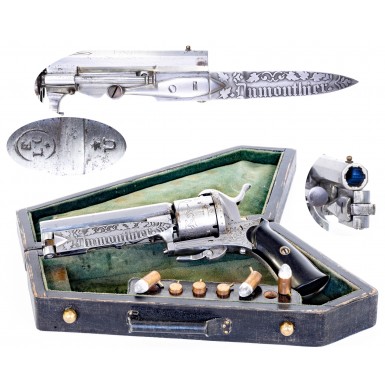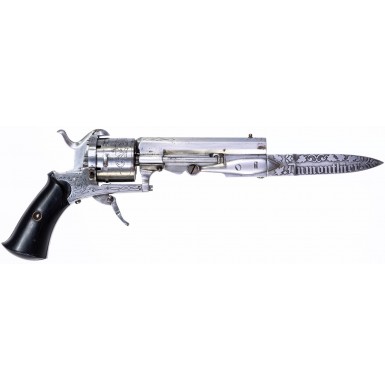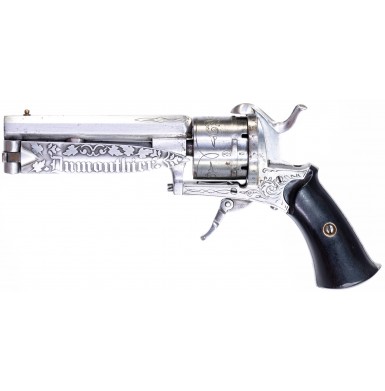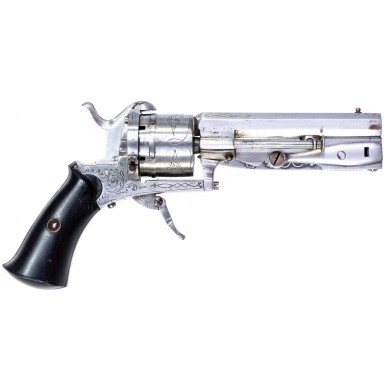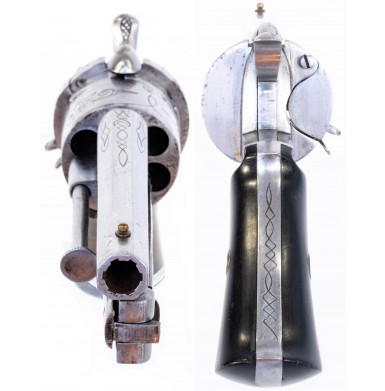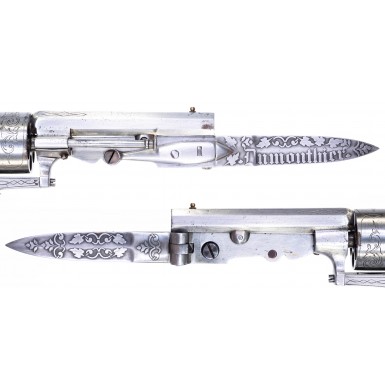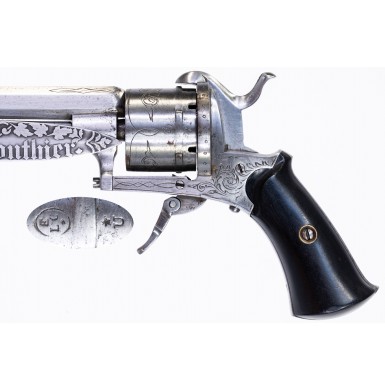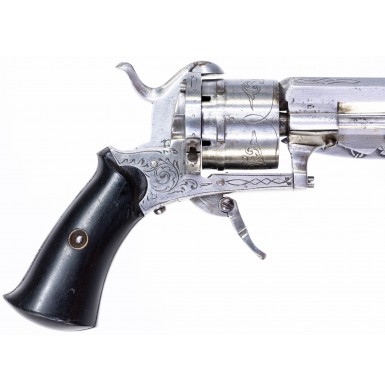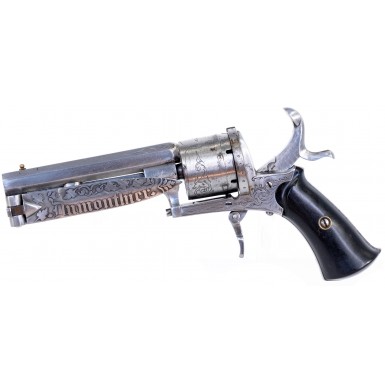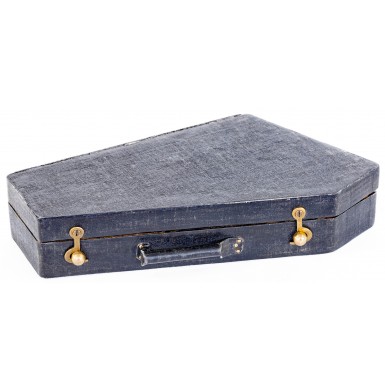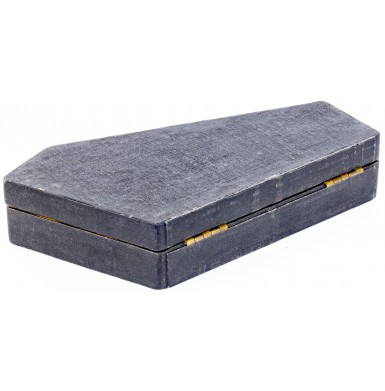Lovely Cased Dumonthier Pinfire Revolver with Folding Dagger Blade
- Product Code: FHG-3535
- Availability: In Stock
-
$3,995.00
Joseph-Célestin Dumonthier was a French gunsmith working during the second half of the 19th century who was most famous for his combination weapons which mated firearms and edged weapons. He is probably best known for his large combination knife-pistols that typically combined a large knife blade with a pair of percussion (later cartridge) pistol barrels on either side of the blade. During his working life, Dumonthier received a number of French firearms patents during the mid-19th century. His first was #11875 issued in 1840 for a “couteaux de chasse pistolets” or “hunting knife with pistols”. This was certainly not a new concept, as hunting swords combined with firearms barrels had been around for more than a century before Dumonthier received this patent, but he refined the mechanism and made the combination of the blades and barrels far more aesthetically pleasing. Dumonthier also received a French patent in 1849 for an early breechloading underhammer pinfire pistol in 1849 and was receiving patents for the improvements in firearms designs in Great Britain into the 1870s.
While the concept of combining edged weapons with firearms was certainly not invented by Dumonthier, he certainly refined the idea and produced some extremely high-quality examples. Some of his work was so impressive that his knife pistols are in the collections of such institutions as The Metropolitan Museum of Art and the Art Institute of Chicago. Dumonthier also produced high quality concealed weapons in the form of cane guns, another concept that he helped to refine and improve. As noted, Dumonthier is probably best known for his refinement of the double-barreled knife pistol, but he also incorporated blades into revolvers as they became the predominant form of handgun being produced in the 19th century. Most of these combination guns incorporated a large, fixed Bowie-style knife blade under the barrel of a pinfire revolver, much like a revolving version of the venerable Ames produced Elgin Pistol Cutlass. A less often encountered Dumonthier variant were his pinfire revolvers that incorporated a folding knife blade. Harkening back to the days of the 18th century “snap bayonet” that was often included on English pistols and blunderbusses intended for use by coachmen in protection of their passengers and cargo, these revolvers could also be seen as somewhat more refined versions of the Dolne Apache handguns that became popular in Europe during the third quarter of the 19th century. The “Apache” typically combined a knife blade, brass knuckles and a pinfire pepperbox design into a single small self-defense handgun that could be concealed with some degree of ease. While a revolver with a fixed knife blade was impressive to look at and would certainly make any potential mugger rethink their plan to rob a potential mark, those guns required a large holster for carry. A revolver with a folding blade could be more easily carried and concealed and could still be deployed as an edged weapon if the situation required it.
The Dumonthier Knife Revolver offered here is a lovely example of his artist combination of a mid-sized pinfire revolver with a folding dagger. The 9mm pinfire revolver has six chambers and a 4” octagonal barrel with an overall length of just under 8” with the blade folded into its stored position. The fold out 3 5/8” double-edged spear point knife blade is ¾” wide at the ricasso and is mounted under the revolver’s barrel and folds out from the left side. The obverse of the blade is deeply etched Dumonthier in a Gothic font with a flowing foliate wreath above the name. The reverse of the blade is deeply etched as well with foliate and geometric themes. With the blade extended the weapon measures nominally 12” in overall length. The revolver is contained in a lovely asymmetrical pentagonal shaped case that is vaguely coffin shaped. The case measures 10 ¾” in length across the longest portion and is 2” thick. The case has two brass hinges and two brass clasps that secure the lid. The wooden case is covered in black oil cloth that in likely intended to resemble a leather covering. The interior of the case is fitted to the revolver with a block that holds six 9mm pinfire cartridges. The casing is lined in dark green velvet with a velvet pillow in the lid.
The revolver is a typical folding trigger, solid frame pinfire revolver from that was produced in large numbers from the late-1850s through the 1870s in Europe, primarily in Belgium but in France as well. The revolver loads via a loading gate at the right rear of the recoil shield and is hinged at the top. An ejector rod is mounted on the right side of the frame. The revolver is finished “in the white” and is lightly engraved with simple foliate motifs and open scrolls on the rear portion of the frame and cylinder and with simple intertwined lines on the lower portion of the frame, on the top and upper angled flats of the barrel and along the backstrap. The cylinder has a Liège E/LG/* proof in an oval along with a */U controller mark. The */U is repeated on the right side of the barrel, above the ejector rod housing. A plain U is present on the face of the cylinder as well. The revolver is otherwise unmarked, with the exception of what appear to be assembly matching and order numbers. These include a 10 on the lower front of the obverse frame, a 9 under the barrel web and on the tang of the knife blade, concealed by the ejector rod head. This is also an 8 on the inner face of the loading gate, the rear face of the cylinder and inner face of the barrel web. There is a small G on the right side of the grip frame, under the grip. The revolver is mounted with flared bottom two-piece smooth ebony grip panels.
The revolver remains in about VERY GOOD+ condition overall. The metal shows no signs of having ever been blued or having been finished in any way and bright steel was not an uncommon way for pinfire revolvers to be finished during the period. The metal appears to have been lightly cleaned at some point in time and shows some scattered areas of light pinpricking here and there, along with scattered areas of freckled oxidation and age discoloration. There are also some small areas of brownish surface oxidation scattered on the cylinder that seem to be the result of storage in the case and contact with the pillow. This would likely clean off with a little careful effort. The engraving on the gun remains clear and crisp and the deep panel etching on the knife blade remains clear and crisp as well. The revolver remains mechanically functional and operates as it should. The revolver times and indexes as it should and functions crisply. The folding knife blade locks securely into position and folds smartly into the storage position where it remains secure until opened intentionally. The bore of the revolver remains in VERY GOOD+ condition as well and is deeply rifled with six grooves that are slightly narrower than the lands. The bore is moderately oxidized and shows scattered light pitting but retains strong, crisp rifling. The ebony grips are solid and free of any breaks or repairs. They show scattered bumps, dings and handling marks, including some minor surface scuffs and scratches. There is also a tiny chip missing from the lower left flared rear edge of the ebony grip. The case remains in similarly nice condition with some moderate light wear on the exterior surface, showing some slight scuffs and scratches. The hinges are solid and the clasps function as they should. The interior of the case shows moderate wear as well with some fading and staining to the green velvet lining with much of the brownish discoloration in the pillow the result of long-term contact with the revolver’s cylinder. The case includes a block that holds six pinfire cartridges and six original cartridges are present in the block. These cartridges will not be included if the revolver is shipped in any way other than by UPS Ground due to regulations regarding the shipment of ammunition and will not be sent to any locality that restricts the delivery of ammunition via common carrier.
Overall, this is a lovely example of a Dumontier Knife Revolver in an attractive case and with the less common feature of including a folding, rather than fixed knife blade. These interesting combination firearms have always been a popular item to collect for those who are fascinated by firearms curiosa. Whether your interest is in pinfire revolvers, combination weapons or curiosa, this lovely Dumonthier Knife Revolver will be a fine addition to your collection and will certainly display wonderfully.
Tags: Lovely, Cased, Dumonthier, Pinfire, Revolver, with, Folding, Dagger, Blade

